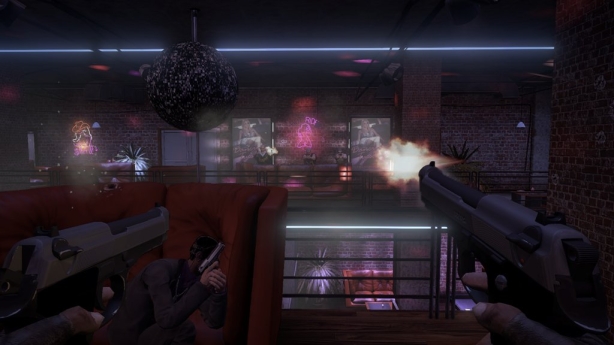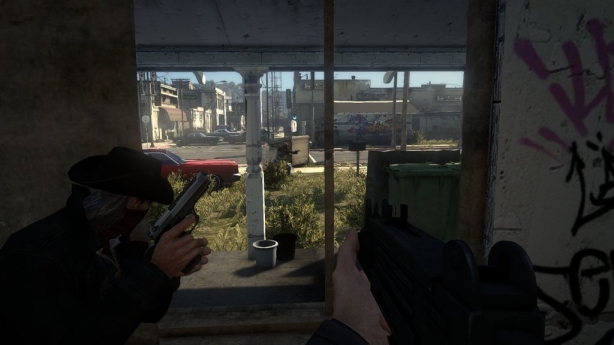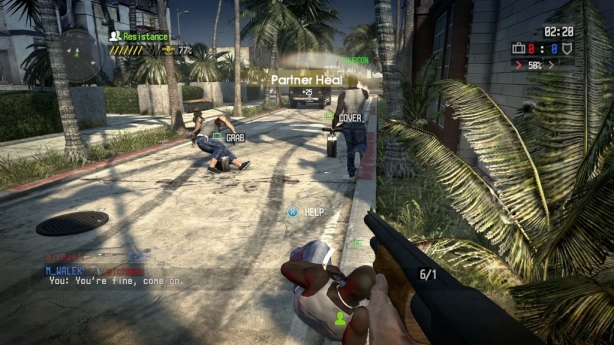Call Of Juarez: The Cartel Review
![]() Game: Call of Juarez: The Cartel
Game: Call of Juarez: The Cartel
Developer: Techland
Publisher: Ubisoft
Available on: Xbox 360, PlayStation 3, Windows PC (Xbox 360 version reviewed)
In the ultra competitive First Person Shooter market, the Wild West based Call of Juarez series has managed to somehow survive without ever truly becoming a hit at retail. Critics have generally been favourable towards the first two Juarez games, but they haven’t really made their mark on the gaming landscape. Enter Call of Juarez: The Cartel. With it comes a new time period and setting. Replace the badlands of the Old West with the mean streets of Los Angeles, and modern-day Mexico. Will this update successfully replicate the atmosphere of the old titles, bringing the Western into the Twenty-First Century, or does it mark a misstep from the well-worn trail?
STORY: The game begins in Los Angeles in 2011, and we learn that a top DEA agent has been killed in a bombing of the DEA offices. It is belived that the Mendoza drug Cartel are responsible for the attack. This is where one of the few links to the previous Juarez games lies, as Mendoza was the surname of the antagonist in the first two games. Mendoza Cartel insider Antonio Alvarez was under investigation by the deceased DEA agent Patrick Stone, and it is believed the Cartel eliminated him to prevent the DEA cutting off their arms supplies. We enter the action as a major task force is being put together by the Government.
This task force is your team of crime-fighters, and players will have the choice of whose boots they wish to step into. The three are; fifty-eight year old LAPD Detective and Vietnam Veteran Ben McCall (who is in actuality a descendant of Juarez series protagonist Ray McCall), FBI Agent Kimberly Evans, and DEA Agent Eddie Guerra. The interesting point to the story is that it will differ slightly depending on which character you choose to play as. Each one has their own motivations and their own weaknesses. McCall served in Vietnam with Stone and Alvarez, and has unfinished business, Guerra was present at the DEA office bombing and left as the only survivor, and Evans is out to protect her brother Deon, who has been swept up in the gang violence of the Cartel. It is from this point that the three-person team sets out to track down Alvarez and unearth more information that could lead them to the truth behind the bombing.
The story could be something straight out of a modern day thriller flick, complete with many racial stereotypes and by the numbers action sequences. There is little in the story to surprise the player or to mark it out as different, and none of the characters are ever really developed enough to become likeable or strong heroes. They all spout so many obscenities, whilst perpetuating the kind of characters that we see in all L.A. cop shows, that it soon becomes tired. The fact that each character does have a slightly branching storyline whereby they may be given sub-missions and secret agendas to complete, is an intriguing one. This does throw a different dynamic into the mix, where a character wants to complete a task secretively, and creates an atmosphere of distrust. Having this background behind the relationship of the main protagonists is a good idea, but this is sadly let down by the fact that the game was obviously designed primarily as a three player co-op experience, and some aspects don’t operate properly in solo play.

GRAPHICS: It is clear from the start that visually this game isn’t going to knock the socks off anyone. The character models and animation both appear quite awkward and unnatural in cinematic cutscenes. Their movements are neither smooth or realistic, often looking distractingly out of place. Detail in the faces of the main characters is stronger, with more distinct features being created, but the other in-game NPC’s are regularly reused and uninspiring. For instance, in one scene where a group of women have been kidnapped, they all look identical. Stranger still, they all look exactly the same as all of the strippers that you encounter in a previous mission. Surely when playtesting, someone would have realised that these faces repeat too often, and a little more variety would have given the game a more polished look.
Environments are more impressive, being steeped in far more detail. They actually manage to look real and lived in. From the clan graffiti scrawled across the walls of gang hideouts, down to the wheelie bins and flaming dumpsters populating the grim back-alleys, the environmental artists have built areas of the city that are convincing. Even areas that are slightly off the beaten track receive the same level of attention, and with the number of secret items that are littered around for players to collect, the exploration of these scenes is encouraged. Strangely though, the game chooses to employ pixelated text and objective markers, along with a heads-up display that looks equally 8-bit. This is an unusual design choice as it is very jarring against the gritty realism of the setting. Following a series of pixelated dots on the horizon as you make your way through a level doesn’t sit very well with the overall design of the game. It is inexplicable why subtitles appear in a similarly rough font, which may have suited a retro-styled title or even a sci-fi game, but doesn’t tie in with the Call of Juarez aesthetic.
SOUND: For those of you who have played past games in the series, you will notice that some musical themes from the past games have been reused and integrated into the score of this third instalment. This of course does conjure up images of the Old West (despite the present-day setting) but when these themes are scattered inbetween sections of modern music, it comes across as somewhat of a mess. This has obviously been done in order to provide a link back to the roots of the series, but once again it is an unnatural fit, sitting in stark opposition with the hip-hop tunes and Film-style action scores. Sound effects are more successful, with the whizzing of bullets and rattling of automatic weapons really hitting the mark, providing an authentic feeling that you are firing accurate replicas of the real thing.
The voiceover work also has issues however. The quality varies wildly from loud and clear, to quiet and tinny. Sometimes there is so much reverb in the recording that the scene sounds like it was recorded in a metal box. This is seemingly done intentionally, as this occurs often in scenes where the characters are driving, but still the quality is questionable. Couple that with the fact that characters frequently speak over one another, and the audio is once again drawn into question. Players are also treated to such unrealistic instances as the occasion of uncovering a cargo container full of Marijuana, whereby your teammates will comment on the contents immediately, even if they have already moved on to the next room and are in the middle of a gunfight. Whoever put together the subtitles in the game is also at fault, as the words written rarely show an accurate transcript of what has actually been spoken. This all points towards a rushed development, and could have been ironed out given a more thorough run through.

GAMEPLAY: Luckily for most gamers, despite its presentational faults the title manages to provide a solid, albeit basic, shooting experience. It also attempts a few gameplay features that are highly original, even though it doesn’t pull them all off effectively. Firstly, the shooting system is solid, with good recoil mechanics and a variety of heavy, medium and light firearms at your disposal, all having their own attributes and being better suited to different situations. We hark back to the Wild West roots once again as the option to dual wield your revolvers is left in the game, and using each trigger to control one gun is quite a satisfying experience let down only by the fact that when firing like this, players cannot enter an aiming mode. This is perhaps more of a reflection on reality however, as when firing two pistols at once, a level of finesse is bound to be sacrificed.
There are a few extra action features that help mix up the action. The Focus Mode which was present in previous Call of Juarez games is once again present, allowing players to slightly slow down the action and pick their shots more carefully. This power is built up by attaining successful enemy kills, and once filled, can be activated at the will of the gamer. Employed at the right time, this can really help in a tight situation. This feature is stretched further through the room entry mechanic. At certain points in the game, the player and their partners line up either side of a door before storming through, once again in slow motion. This produces the same result as Focus Mode, and does eliminate some of the risks of blindly walking into a dangerous situation, but it probably occurs a little too often for its own good.
Another sequence that constantly reappears is the cover and draw system. When under heavy fire, you must wait in cover for your partners to draw the fire of the enemies, before you proceed to the next section of safe cover. After doing this several times, you will have worked your way closely to your opponents, often flanking them for the surprise kill. Again, this inventive idea suffers due to the frequency at which is happens. This recurring trilogy is completed by the in-game driving sequences. These will occur at the start of most missions, and involve a player driving their car whilst their partners shoot at opposing vehicles. The car handling is light and jerky, and the in-car view of the road is so awkward that it is very difficult to clearly see where you are going. Had a view change option been present, these sections may have been better, but you are always stuck with the same view. In co-operative play, players take turns to drive in these sequences, however in single-player, you will almost always be the driver. This makes these sections highly tedious, especially when you have to rely on the less than desirable shooting skills of the AI. Add on top of that the fact that you can easily stray out of bounds when in the car causing the mission to re-start, and the frustration really kicks in.
The main new features that have been included in The Cartel are the secret items and hidden agendas. One example of this is that fact that Guerra has a Gambling problem and is in huge amounts of debt. If playing as Guerra, you are tasked with secretly confiscating drugs that you find at crime scenes, in order to fund your habit. When playing as McCall however, your superiors ask you to keep an eye on Guerra, and report if you see him dipping into the evidence. This is a great idea, and when played through properly in three-player co-op really does create an extra level of competition and distrust between players. Competing to make sure your partners aren’t crooked, whilst trying to bend some laws yourself without anyone noticing can be thrilling and get the adrenaline pumping. However, as I touched upon earlier, this mode doesn’t operate fully in single-player. You are still meant to collect secret items yourself, and the AI partners can rumble you, but they never collect items, making one side of the mechanic completely redundant. Perhaps it proved too difficult to catch the AI in the act, but disabling this option for your computer controlled partners severely limits the scope of the single-player experience.

The same problem occurs with the hidden agenda missions. You will be asked to perform a specific side-mission, but your partners don’t perform theirs. As McCall, a “friend” who has had her belongings stolen asks you to recover money for her from a crime scene, and if you do so, you will earn experience points for your trouble – this is true of successful secret items you find also. As you collect more XP, you will unlock new weapons to use in future levels. This is the only real reward for successfully completing side-missions (aside from Achievements) and it won’t affect the storyline at all. Again, your teammates will be able to spot you doing this and ruin your mission, but in the single-player game they won’t ever perform their risky hidden agendas. These new additions therefore have suffered from implementation issues. Handled correctly, this would have enhanced all game modes, but instead, it furthers the co-op game whilst hindering the single-player one.
MULTIPLAYER: I have already touched upon the strengths of the three-player co-operative multiplayer, as hidden agendas and secret items really come into their own here. Your paranoia concerning your partners will grow throughout the levels, and this makes the game a more competitive experience despite the fact you are all working toward the same overall goal. Another piece of the equation is the mid-level challenges. For instance, at certain points a specific challenge will appear on-screen. Which player can perform twenty headshots first? Who can melee five enemies before anyone else does? Whoever wins these challenges is also rewarded with bonus XP, bringing them one step closer to that new Shotgun (which unfortunately, they would probably unlock anyway without really trying in one single-player story play-through). These are presented to players in the same messy style as all the in-game text, and certainly takes away somewhat from the immersive atmosphere of contempt that the other features have worked so well to earn.
On top of co-op modes, there are the usual run of the mill online competitive modes. There’s a traditional Team Deathmatch mode, in which cops face off against criminals, with the aim being to kill each other; pretty self-explanatory. The other mode is Objective Mode, where once again the two teams are made up of Policemen and drug traffickers, but this time the aim of the game is to complete different objectives you have been given. This might be collecting a certain amount of drugs and removing them safely if you are the bad guys, or making sure the drug smuggling is stopped short, if you take on the role of the law-makers. These modes aren’t exactly exciting, but another new idea has been introduced, in the form of the Partner feature. Each gamer in the match is coupled up with a partner from their team. You are then rewarded for sticking together with your partner and working as a team. Extra XP or faster health recharging might be your reward, but the game also alerts the two partners via radar, whenever the other is under fire, so it is easier to come and ride to the rescue of your buddy.
Just like the co-op mode tries to integrate competitive features, the competitive mode tries to work some co-operative ideology into the gameplay. This is an interesting idea, but hinges solely on the willingness for two partners to communicate. As is the case with the main story mode therefore, the game is best experienced when played with friends.

LONGEVITY: You won’t get to enjoy all of the features the game can offer playing this game alone, or possibly even with strangers, and that does result in the title being of somewhat niche interest, only to those who do have a few friends to play regularly online with. This limits the replay value as, despite having three varied characters to play as, each with their own (slightly different) stories, you may well find little motivation to play through the repetitive single-player mode more than once. Played alone, the game becomes a series of repeated set-pieces, with little variety or excitement thrown in. The attaining of Achievements won’t keep you busy for long either, with many being unlocked through story progression, whilst others, such as kills with particular weapons, you will simply stumble upon in a regular playthrough.
VERDICT: Perhaps if the game had been marketed as primarily a three-player co-op title, and sold at a lower price point because of this limitation, it would be judged more fairly. As it is, the game is unbalanced. If the new ideas and features had been successfully applied throughout all game modes and perhaps employed a little more sparingly, in order to maintain the feeling of freshness, the game would have made some very inventive strides for the genre. Instead, the innovations flounder a little through poor application.
The move away from the Wild West has stripped the series of the strong identity that is carried through the first two games in the franchise. What we are left with is something that feels rather shallow and uneven. The storyline is compelling enough that you’ll want to find out where it is heading, but the characters are one dimensional and it certainly doesn’t feel like a modern-day Western. So perhaps that is the hope for this series? To go back to the setting that was so successful previously, but continue to innovate and try to bring new ideas to a genre which all-too-often can be found resting on its laurels. Had this game been developed for a bit longer, and been afforded a new graphical engine to play with, it could have brought a lot of new ideas to the table. As it stands however, this game may well be forgotten in the dust.






